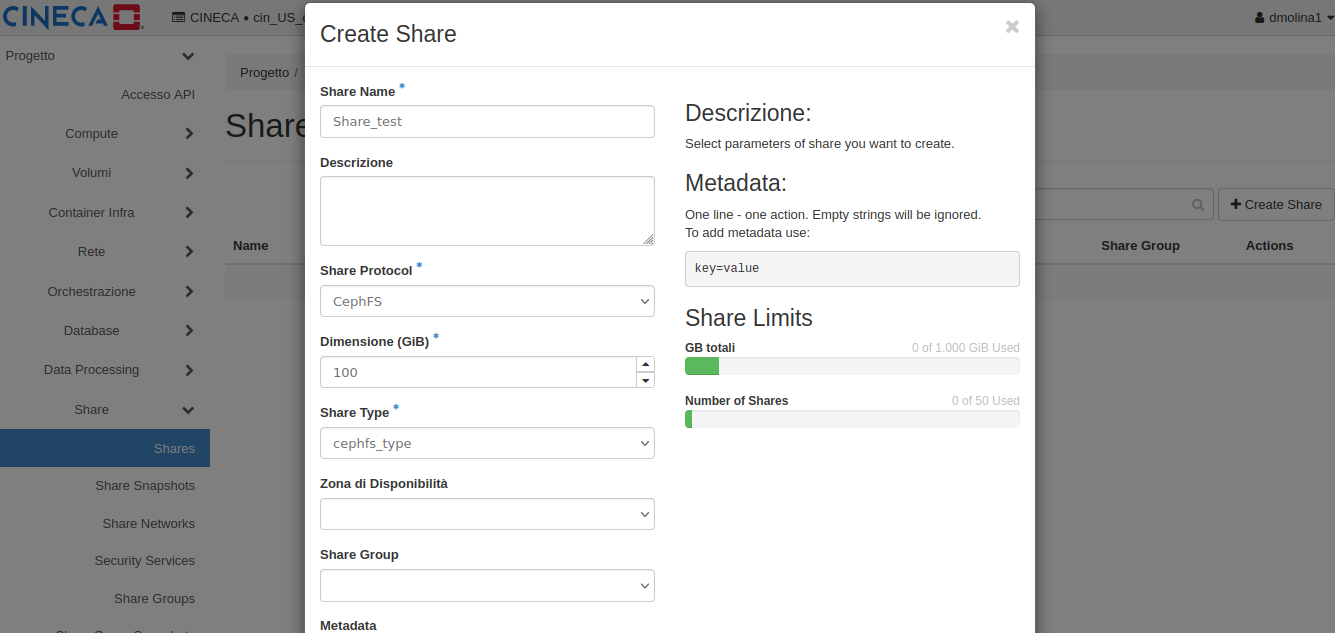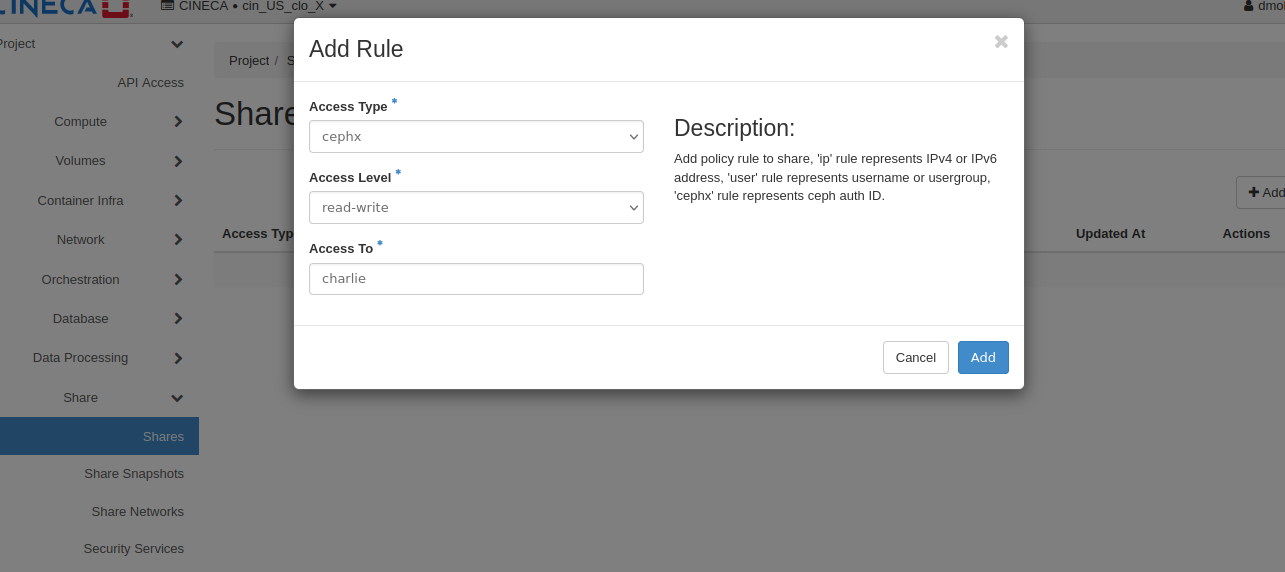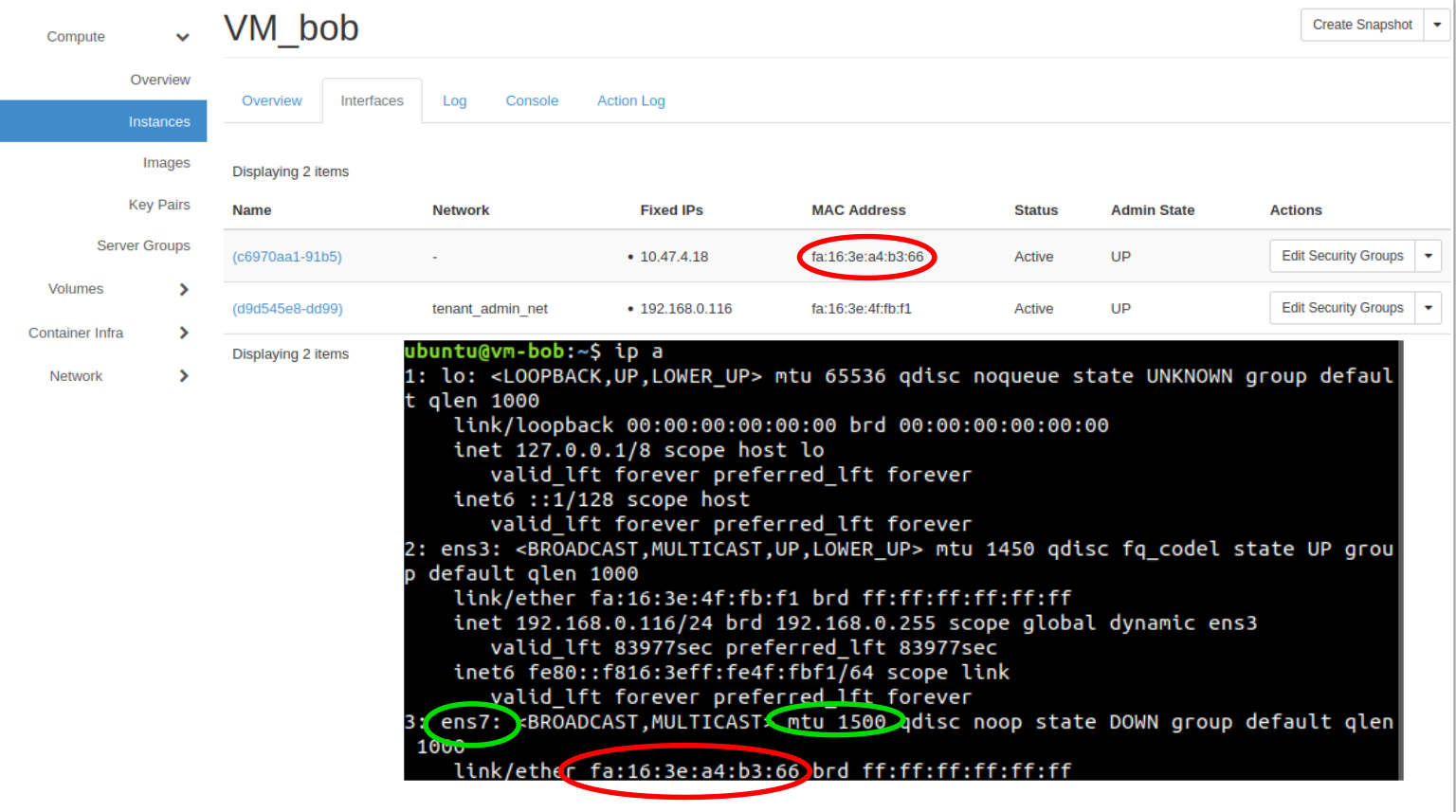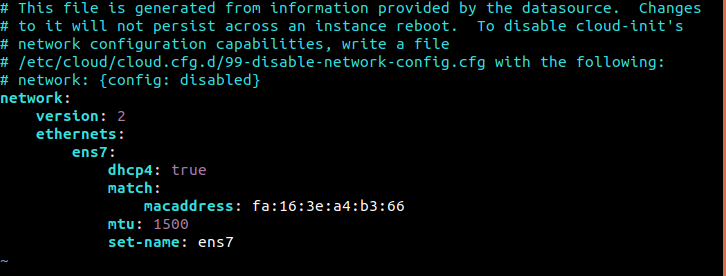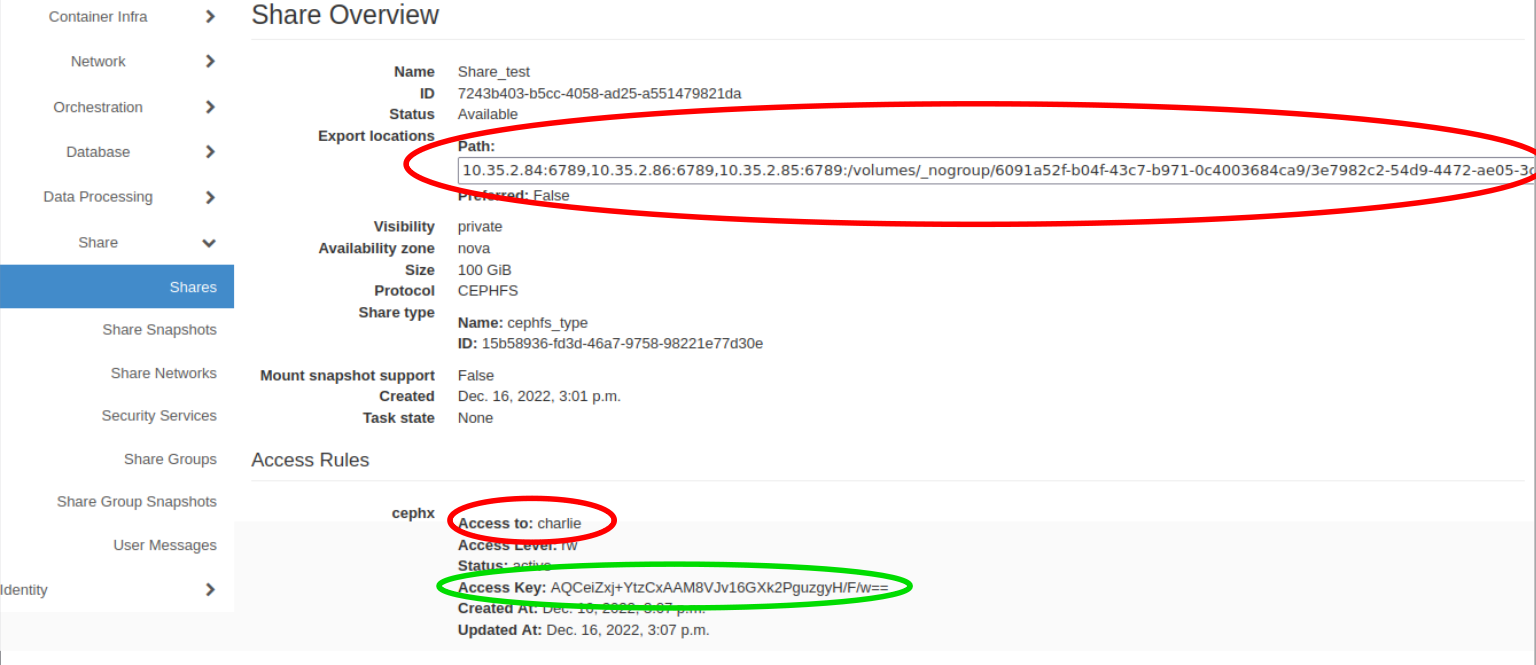Introduction
This guide is for users that aim to create a shared filesystem in their virtual machines using the OpenStack Manila service.
The OpenStack Manila service allows the creation of a filesystem that can be shared among virtual machines in the same tenant (intra-tenant) or in different tenants (extra-tenant).
More details on Manila's service can be found here.
In ADA Cloud, two share types are available: generic_type (NFS protocol) and cephfs_type (CEPHFS protocol). We advice the users that needs a shared filesystem to utilize the generic_type.
Important: Only intra-tenant shares are allowed on ADA Cloud.
How to create and use a GENERIC_TYPE share
The following sections describe the steps needed to create a share and mount it on two VMs attached to a local network. Note that the user needs to configure the VMs in a way that allows logging in via ssh.
Request to be enabled to the service
The user willing to make use of the Manila service needs to send an email to superc@cineca.it, communicating
- how many shares are needed.
- their dimensions (GB).
- the tenant's name.
Once the tenant is enabled to the service by the User Support Team, all users of the tenant will be able to use the service.
Create share network
As a first step, the user needs to create the share network by clicking on "Project → Share → Share Networks → "Create Share Network" and set the value for the following attributes:
- Share network name.
- network: choose the desired network, in our example example_share_guide_net.
- subnet: choose the desired subnet, in our example example_share_guide_subnet.
- Click on the "save" button.
Create the share
Then, the creation of the share is performed by following the next steps:
- Create the share by clicking on "Project → Share → Shares → "Create Share" and setting the following information:
- share name
- share protocol == "NFS"
- size (on the right side is visualized information about the actual available and used space within the tenant)
- Type == "generic_type"
- Leave blank the option "Make visible for all projects" because it is not enabled
- In the end, click on the "create" button.
Set the access rule(s) on the share just created. On the OpenStack dashboard click on "Project → Share → Shares", then select the share just created and in the menu on the right select "Manage Rules".
Click on "Add rule" and set:
access type: Choose "ip", the rest of options displayed are not available for NFS share's protocol.
access level: read-write or read-only (depending on your needs)
access to: write the IP with permission to access the share. Only one entry is allowed per rule, therefore, you will have to include a rule for the fixed-IP of each VM.
- Finally, click on the "add" button.
Mount the share on the VMs
The user is now ready to mount the share on VMs. In the following example, we will consider two VM with Ubuntu 22.04 OS. Please refer to the network guide of the operating system of your VM to be sure about the actions to be performed. The steps are the following:
- Login into the first VM.
- Upgrade the packages installed in the VM:
sudo apt update sudo apt upgrade
Install the client. The package name is "nfs-common".
sudo apt install nfs-common
- Identify or create the directory in which the share will be mounted (e.g., "/mnt/share_manila")
sudo mkdir <MOUNT_PATH>
- To mount the share you will need the share <ACCESS_PATH> displayed on the "Share Overview" page on OpenStack dashboard under the keyword "Export Location/Path". Gather this information and proceed.
- Mount the share with the following command. Beware that different versions of nfs-common are available for different versions of Ubuntu and the syntax of the mount command could change.
sudo mount -t nfs -v <ACCESS_PATH> <MOUNT_PATH>
- Then, repeat the same steps for the second VM.
How to create and use a CEPHFS_TYPE share
Request to be enabled to the service
A user that would like to make use of the Manila service needs to send an email to superc@cineca.it, communicating how many shares are needed and for each share:
- its dimensions (GB)
- the instance name of the virtual machines (VMs) that will share that filesystem
- the tenant's name.
Once enabled by the User Support Team, the user needs to create the share and mount it in a special network interface on the VMs attached to a dedicated storage network.
As an example, in what follows, we will create a share in common between VM_alice and VM_bob belonging to the same tenant.
Create the share
You can create a share by following the below steps:
- Create the share by clicking on "Project → Share → Shares → "Create Share" and set:
- share name
- share protocol == "CephFS" (other cases not allowed)
- size (on the right side is visualized information about the actual available and used space within the tenant)
- Type == "cephfs_type"
- Leave blank the option "Make visible for all projects" because it is not enabled
- In the end, click on the "save" button.
- Set the access rule on the share just created. On the OpenStack dashboard click on "Project → Share → Shares", then select the share just created and in the menu on the right select "Manage Rules".
- Click on "Add rule" and set:
- access type: cephx
- access level: read-write or read-only (depending on your needs)
- access to: write the name of the client (in our example "charlie")
By clicking on the "add" button the dashboard will show the "access key" and "access to" keys that must be used to mount the share on the virtual machines.
Mount the share on the VMs
The user is now ready to mount the share on VMs. In the following example, we will consider two VM with Ubuntu 20.04 OS.
Please refer to the network guide of the operating system of your VM to be sure about the operations to be done.
Login in the first VM, then:
- configure the network interface attached to the storage network
- "ip a" command lists all the network interfaces. Find the new interface, attached to the storage network, and refer to the mac-address of the interface to be sure.
Create a new file in the /etc/netplan directory to configure such new interface (in our example "ens7"), and enable it
$ sudo su
$ cd /etc/netplan
$ cp <file-cloud-init> <file-ens-number> - example: cp 50-cloud-init.yaml ens7.yaml -
$ vim <file-ens-number> ==> Modify the value of the fields "ens", "mtu <value>", "macaddress <value>" and "set-name < value>" with the values shown by "ip a" command.
-- example of the ens7.yaml is --
network:
version: 2
ethernets:
ens7:
dhcp4: true
match:
macaddress: <your MAC address>
mtu: <MTU value>
set-name: ens7
$ netplan apply ==> to enable the new interface
$ ip a ==> check that the interface is enabled
- Install the client, by installing the package named "ceph-common " (on Ubuntu)
- Create the mount point in the virtual machines (in our example "/mnt/share_manila") and mount the share
To mount the share you will need some informations contained in the "Share Overview" page on OpenStack dashboard, in particular you will need the values of PATH, ACCESS_TO and ACCESS KEY (here an example):
Beware that different versions of ceph-common are available for different versions of Ubuntu and the syntax of the mount command could change.
For Ubuntu 20.04, the command is:
sudo mount -t ceph -v <mount PATH> <mount point on the VM> -o name=<CLIENT_ACCESS_TO>,secret=<ACCESS_KEY>
An example of the complete command is:
sudo mount -t ceph -v 10.35.1.9:6789,10.35.1.10:6789,10.35.1.11:6789,10.35.1.12:6789,10.35.1.13:6789:/volumes/_nogroup/43aa4ecc-1db6-4952-b2dd-6336b45075d5 /mnt/share_manila/ -o name=my-client-name,secret=AQBP07Nejv/RLhAABYqQ5tvgePh2EP7EL0UuhQ==
While, for Ubuntu 22.04 and higher the command is:
sudo mount.ceph <CLIENT_ACCESS_TO>@482d24d4-df47-11eb-8d80-0c42a1f53648.g100_fs=<FS_ADDRESS> <mount point on the VM> -o mon_addr=<MON_IPS>,secretfile=<SECRET_FILE>
Where <FS_ADDRESS> and <MON_IPS> are the two parts of the "Path" string on OpenStack:
- <MON_IPS> is the first numeric part of the "Path" string, up to ":/volumes", where each IP has to be separated using the character "/" instead of ","
- <FS_ADDRESS> is everything else, from "/volumes/" to the end of the string
Finally, the <SECRET_FILE> is the path to a text file that contains the string <ACCESS_KEY>. Following the same example that uses the picture from above:
sudo mount.ceph charlie@482d24d4-df47-11eb-8d80-0c42a1f53648.g100_fs=/volumes/_nogroup/43aa4ecc-1db6-4952-b2dd-6336b45075d5 /mnt/share_manila/ -o mon_addr=10.35.1.9:6789/10.35.1.10:6789/10.35.1.11:6789/10.35.1.12:6789/10.35.1.13:6789,secretfile=/home/ubuntu/my_secret_file.txt
NB: If you are using a different Linux distribution, please refer to the ceph user manual to be sure that the syntax you are using is appropriate for the ceph version installed.
Then repeat the same steps for the second VM as well. Now the two VMs share the same filesystem.





